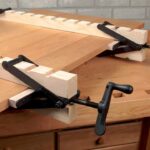Woodworking is an art that involves crafting beautiful and functional pieces from raw lumber. However, the success of any woodworking project heavily relies on selecting the right type of wood. Whether you’re a beginner or an experienced woodworker, understanding the basics of choosing lumber is essential to ensure the best outcome for your projects.
In this article, we will guide you through the process, covering everything from the importance of lumber selection to identifying your project requirements. By the end, you’ll be equipped to make informed decisions and embark on your woodworking journey with confidence.
Before diving into the details, it’s crucial to grasp why choosing the right lumber is vital for woodworking projects. The quality and characteristics of different types of wood can significantly impact the durability, stability, and workability of your creations.
Moreover, factors such as lumber grades, grain patterns, and moisture content can determine how well your finished piece will fare over time. By familiarizing yourself with these aspects, you’ll be able to select wood that aligns with your project requirements and achieves optimal results.
To begin our exploration into the world of choosing lumber for woodworking, we’ll delve into understanding common types of wood used in woodworking and their individual characteristics. From hardwoods like oak and maple to softwoods like pine and cedar, each type possesses unique qualities that make them suitable for specific applications. By gaining knowledge about various woods’ attributes, you’ll not only expand your options but also be able to choose the perfect material that complements your envisioned piece.
In the next sections, we’ll further assist you in defining your project goals by assessing its type, scale, and required techniques. We’ll explore key considerations when selecting lumber such as durability and stability while also delving into sourcing options for quality wood. Additionally, we’ll discuss important factors like grain patterns and defects that can influence your choice.
Finally, we’ll wrap up with tips specifically tailored for beginners in woodworking to make their lumber selection process easier and safer. So let’s get started on this journey of mastering the art of choosing lumber for woodworking.
Identifying Your Project Requirements
When embarking on a woodworking project, it is essential to identify your project requirements and define your woodworking goals. This step will help you choose the right lumber for your specific project needs. Assessing the type and scale of your woodworking project is crucial in determining the amount and quality of wood necessary.
Consider the woodworking techniques required for your project and how they may impact lumber selection. Different techniques, such as joinery or carving, may require specific types of wood that are more suitable for those techniques. For example, if you plan on creating intricate carvings, a hardwood with a fine grain like cherry or walnut may be a better choice than a softer wood like pine.
Additionally, consider the overall design and style of your project when selecting lumber. The aesthetic qualities of the wood, such as color and grain patterns, can greatly enhance the final result. For example, if you are building furniture with a rustic farmhouse style, choosing knotty pine or reclaimed barnwood would complement the design.
| Factor | Description |
|---|---|
| Durability | The ability of the wood to withstand wear and tear over time |
| Stability | The resistance of the wood to changes in temperature and humidity |
| Workability | The ease with which the wood can be cut, shaped, and joined |
| Lumber Grades | A classification system that rates the quality and appearance of lumber |
By carefully considering these factors and your specific project requirements, you can ensure that the lumber you choose is well-suited for your woodworking goals. This will ultimately result in a successful and satisfying woodworking project.
Key Considerations
When it comes to choosing lumber for woodworking projects, there are several key considerations that should be taken into account. These factors play a significant role in determining the overall success of your project and can greatly impact the final outcome. In this section, we will explore some important factors that you should keep in mind when selecting lumber for your woodworking endeavors.
The first consideration is the durability of the wood. Different types of wood have varying degrees of resistance to rot, decay, and insect damage. It’s important to choose a wood species that is suitable for the intended purpose of your project. For example, if you are building outdoor furniture or structures, it’s essential to select a wood species that is naturally resistant to weathering and can withstand outdoor conditions.
Another factor to consider is the stability of the wood. Wood expands and contracts with changes in environmental moisture levels. This movement can cause warping, twisting, and splitting if the wood isn’t stable enough. Understanding how stable a particular wood species is and taking precautions such as proper drying and conditioning can help mitigate these issues.
Workability is also an important factor to consider. Some woods are easier to work with than others due to their hardness or grain patterns. Consider the tools and techniques you will be using for your woodworking project and choose a wood species that complements them. Softwoods like pine are generally easier to work with than hardwoods like oak or maple.
Furthermore, understanding lumber grades is crucial when making a selection. Lumber grades indicate the quality of the wood based on characteristics such as knots, defects, and overall appearance. Selecting lumber with an appropriate grade for your project ensures that you are using high-quality material while meeting your budget constraints.
By considering these key factors – durability, stability, workability, and lumber grades – you will be better equipped to make informed decisions when choosing lumber for your woodworking projects. Taking into account these aspects will not only enhance the longevity of your creations but also contribute to the aesthetic appeal and functionality of your finished pieces.
Sourcing Lumber
Exploring Local Lumberyards, Sawmills, and Home Improvement Stores
When it comes to sourcing lumber for your woodworking projects, there are several options available. One of the most traditional and reliable sources is local lumberyards. These specialized stores typically carry a wide variety of wood species, allowing you to choose the perfect lumber for your project. Additionally, the staff at lumberyards are often knowledgeable about different wood types and can provide valuable advice on which ones will work best for your specific needs.
Another option is to visit sawmills in your area. Sawmills are where logs are transformed into usable boards, making them an excellent place to find high-quality and unique lumber. Many sawmills also offer custom cutting services, allowing you to request specific dimensions and cuts for your project.
Home improvement stores such as big-box retailers can also be a convenient source of lumber. While they may not offer as extensive a selection as specialty stores or sawmills, these stores usually stock common wood species that are suitable for various woodworking projects. They may also provide additional services like cutting wood to size or offering pre-cut boards, making it easier if you don’t have access to more advanced cutting tools.
Online Options for Purchasing Lumber and Their Pros and Cons
With the rise of E-commerce, purchasing lumber online has become a popular choice for many woodworkers. Numerous websites specialize in selling hardwoods and softwoods online, providing an extensive range of choices from different wood species to various dimensions.
One advantage of buying lumber online is the convenience it offers. You can browse through numerous options from the comfort of your own home and have them delivered straight to your door. This saves time and effort compared to physically visiting multiple stores or mills in search of specific types of wood.
However, it’s important to note that when purchasing lumber online, you won’t have the opportunity to inspect the wood in person before buying. While reputable online retailers often provide detailed descriptions and images of the lumber, it’s still a good idea to research customer reviews or seek recommendations from other woodworkers to ensure the quality and reliability of the supplier.
Overall, the choice between sourcing lumber locally or online depends on personal preferences and the level of convenience desired. Some woodworkers may enjoy the hands-on experience of selecting wood in person, while others may appreciate the ease and selection offered by online retailers.
Summary
Sourcing quality lumber for woodworking projects can be done through various avenues, including local lumberyards, sawmills, home improvement stores, and online retailers. Each source has its advantages and considerations to take into account. Local lumberyards and sawmills offer a wide range of choices, along with valuable expertise from knowledgeable staff.
Meanwhile, home improvement stores provide convenience for those seeking common wood species and additional services like cutting wood to size. Online options offer a vast assortment of woods that can be easily selected from home; however, it requires careful consideration regarding quality assurance when purchasing without physical inspection. By exploring these different sources, you can find quality wood that meets your project requirements while balancing convenience and personal preferences.
Evaluating Wood Characteristics
When it comes to choosing lumber for your woodworking projects, it is essential to evaluate the wood characteristics to make informed choices. The characteristics of the wood can greatly impact the outcome and quality of your project, so understanding how grain patterns, knots, defects, and moisture content play a role is crucial.
- Understanding Grain Patterns: Grain patterns refer to the texture and flow of the wood fibers. It can range from straight and even to wild and irregular. The grain pattern not only adds aesthetic appeal but also affects how the wood behaves during cutting and shaping. For example, wood with interlocked or twisted grain may be more difficult to work with as it can cause tear-out or difficulty in making clean cuts.
- Assessing Knots and Defects: Knots are areas in the wood where branches used to grow. While small knots may add character to your project, larger knots can weaken the structure of the wood. It is important to inspect and assess the quantity, size, and location of knots before selecting your lumber. Additionally, be on the lookout for other defects such as cracks, splits, or insect damage that can affect both aesthetics and structural integrity.
- Understanding Moisture Content: Wood naturally contains moisture that needs to be taken into account when selecting lumber for woodworking projects. The moisture content affects how stable the wood is once it acclimates to its environment. High moisture content can lead to warping, twisting, or shrinking as it dries out over time.
On the other hand, excessively dry wood may expand when exposed to high humidity levels. It is important to consider both short-term and long-term requirements of your project when evaluating moisture content in lumber.
By thoroughly evaluating these wood characteristics – grain patterns, knots and defects, and moisture content – you can make informed choices that will contribute towards a successful woodworking project. Taking these factors into consideration will not only ensure proper functionality but also create visually appealing results.
Selecting the Right Type of Wood
When it comes to woodworking, one of the most important decisions you’ll have to make is selecting the right type of wood for your project. Different wood species offer unique characteristics and benefits that can greatly impact the outcome of your woodworking project. In this section, we will explore popular wood species and discuss how to match them to different types of woodworking projects.
Firstly, it’s important to consider whether your project calls for hardwood or softwood. Hardwood species like oak, maple, and walnut are known for their durability and strength, making them ideal for furniture-making and high-traffic areas. Softwood species like pine and cedar, on the other hand, are more affordable and often used in construction projects such as framing or outdoor structures.
Next, think about whether your project will be used indoors or outdoors. If your piece will be exposed to the elements, it’s crucial to select a wood species that is naturally resistant to decay and moisture damage. Cedar and redwood are popular choices for outdoor projects due to their natural resistance to rot and insects.
Consider the aesthetic qualities you’re looking for in your finished piece as well. Some woods have distinct grain patterns that can add visual interest and character to your project. For example, mahogany is known for its rich color and beautiful grain, making it a popular choice for fine furniture-making.
Lastly, think about the availability of the wood species you’re considering. Some woods may be harder to find at local lumberyards or may come with a higher price tag due to their scarcity. It’s important to weigh these factors when selecting a wood species that matches both your budget and project requirements.
By taking into account the type of wood (hardwood vs softwood), indoor vs outdoor use, desired aesthetic qualities, and availability, you’ll be able to make an informed decision when matching wood species to your woodworking projects. Remember that each type of wood has its own unique characteristics and benefits, so take the time to research and explore different options before making your final selection.
Inspecting and Testing Lumber
When it comes to choosing lumber for your woodworking projects, it’s essential to thoroughly inspect and test the wood to ensure its quality and suitability. This section will cover visual inspection techniques to detect flaws or damage in the wood, as well as provide tips on measuring wood moisture content and understanding the results.
Visual inspection is a crucial step in selecting lumber. By carefully examining the wood, you can identify any defects or flaws that may affect the strength and appearance of your final project. Some common defects to look out for include knots, cracks, warping, insect damage, and discoloration.
It’s important to note that certain defects may be acceptable depending on the intended use of the wood. For example, a rustic piece of furniture may benefit from knots or small cracks for added character. However, structural parts should ideally be free from defects that could compromise their integrity.
In addition to visual inspection, evaluating the moisture content of the wood is vital for ensuring its stability over time. Wood absorbs and loses moisture based on humidity levels in its environment. A high moisture content can result in warping, splitting, or shrinking of the wood once it is used in a project.
On the other hand, if the moisture content is too low, it can cause excessive drying and cracking. To measure wood moisture content accurately, you can use a moisture meter specifically designed for wood. Aim for a moisture level that is appropriate for your project’s final destination-indoors or outdoors-and allow sufficient time for acclimation before starting construction.
By following these inspection and testing practices when selecting lumber for your woodworking projects, you can ensure that you are choosing quality wood that is suitable for your needs. Taking the time to thoroughly assess each piece of lumber will contribute to successful outcomes in your woodworking endeavors.
– Visual inspection techniques:
- Look out for knots, cracks, warping, insect damage, and discoloration.
- Assess acceptability of defects based on intended use of the wood.
– Measuring wood moisture content:
- Use a moisture meter designed for wood.
- Aim for appropriate moisture level based on project’s final destination (indoors or outdoors).
- Allow sufficient time for acclimation before starting construction.
Tips for Beginner Woodworkers
Importance of Safety Precautions
For beginner woodworkers, it is crucial to prioritize safety when working with lumber. Woodworking involves the use of sharp tools and powerful machinery, making safety precautions essential to prevent accidents and injuries. Here are some important dos and don’ts to keep in mind:
Do
- Wear appropriate personal protective equipment (PPE) such as safety glasses, ear protection, and a dust mask.
- Familiarize yourself with the proper techniques for using woodworking tools. Take the time to learn how to handle each tool safely to minimize the risk of accidents.
- Keep your workspace clean and organized. Remove any clutter or debris that could cause accidents or hinder your movements.
- Use clamps or other methods to secure your workpiece before working on it. This will ensure stability and reduce the chance of slips or mishaps.
- Take breaks regularly to avoid fatigue, which can increase the risk of mistakes and accidents.
Don’t
- Rush through a project. It’s important to take your time and work deliberately, especially when using power tools.
- Forget to unplug power tools before making adjustments or changing blades.
- Neglect regular maintenance of your tools. Keeping them in good condition is not only essential for their performance but also for ensuring safer operation.
- Wear loose clothing or jewelry that could get caught in moving parts of machinery.
- Ignore warning signs or instructions on tools and equipment.
By following these dos and don’ts, beginner woodworkers can minimize the risks associated with woodworking projects and create a safe working environment for themselves.
Tips for Easier Lumber Selection
Choosing lumber can be overwhelming for beginners, but there are some tips that can make the process easier:
- Plan ahead: Before visiting a lumberyard or store, make a detailed list of the wood species, dimensions, and quantities you need for your project. This will help you stay focused and avoid impulse purchases.
- Ask for assistance: Don’t hesitate to ask for help from experienced woodworkers or store staff who can guide you in selecting the right lumber for your project. They can provide valuable insights and recommendations based on their knowledge and experience.
- Inspect the lumber: Take the time to visually inspect each piece of lumber before purchasing it. Look for any obvious defects, such as cracks, splits, or warping. Avoid boards with large knots or other irregularities that may weaken the wood.
- Consider cost and waste: Be mindful of your budget when selecting lumber. Opt for boards that are straight and free from defects but also consider how much waste you will generate during the woodworking process. By choosing wisely, you can minimize both cost and waste.
- Start small: As a beginner, it’s best to start with smaller projects that require less expensive or readily available wood species. This will allow you to practice your skills without investing too much money upfront.
By following these tips, beginner woodworkers can navigate the process of selecting lumber more confidently and efficiently, setting themselves up for successful woodworking projects in the future.
Conclusion
In conclusion, selecting the right lumber for your woodworking projects is an essential skill that every woodworker should master. Throughout this article, we have covered the basics of lumber selection, from understanding different types of wood to assessing project requirements and considering key factors. We have also explored various sources for quality lumber, evaluated wood characteristics, and provided tips for inspecting and testing lumber.
By following the guidance laid out in this article, you can make informed choices when it comes to selecting the right type of wood for your projects. Understanding the impact of grain patterns, knots, and defects will help you create pieces that are both aesthetically pleasing and structurally sound. Additionally, assessing wood moisture content is crucial for ensuring long-term stability and preventing issues like warping or splitting.
For beginner woodworkers, it’s important to remember safety precautions while working with lumber. Always use appropriate protective gear and follow best practices when handling tools and equipment. Lastly, don’t hesitate to seek guidance from experienced woodworkers or professionals if you have any doubts or questions.
Now armed with the knowledge gained from this article, it’s time to embark on your woodworking journey with confidence. Whether you’re a hobbyist or a professional woodworker, mastering the art of choosing lumber will greatly enhance the quality of your projects. So go ahead and experiment with different wood species, embrace new techniques, and let your creativity flourish as you craft beautiful pieces that showcase your skills. Happy woodworking.
Frequently Asked Questions
What is the most recommended wood to use for woodworking?
The most recommended wood for woodworking tends to vary depending on the specific project and the desired outcome. However, one type of wood that is often highly recommended is hardwood.
Hardwoods such as maple, oak, or walnut are known for their durability and strength, making them suitable for a wide range of woodworking applications. These woods also have attractive grain patterns and can be stained or finished in various ways to enhance their appearance.
How do you pick a good piece of lumber?
When picking a good piece of lumber, several factors should be considered. First, examine the wood for any visible defects such as knots, splits, or cracks. These flaws can weaken the wood and affect its overall quality.
It’s also important to check for straightness – a good piece of lumber should not be twisted or warped but should have a relatively straight shape. Additionally, assess the moisture content of the wood by tapping it lightly – if there is a dull sound, it signifies that the lumber has been properly dried and is less likely to shrink or warp later on.
How to choose 2×4 lumber?
Selecting 2×4 lumber involves similar considerations as choosing any other type of lumber. Start by inspecting each board for defects like knots, checks (cracks along the grain), or warping. Look for straight boards as well since 2x4s are commonly used as support structures where stability is crucial.
Another important factor to consider is whether you need pressure-treated or untreated 2x4s depending on their intended use – pressure-treated ones are protected against decay and insects while untreated ones are more suitable for indoor projects where these risks are minimal. Finally, compare different options based on price and quality to make an informed decision that best fits your needs and budget.

Hi everyone! I’m a woodworker and blogger, and this is my woodworking blog. In my blog, I share tips and tricks for woodworkers of all skill levels, as well as project ideas that you can try yourself.





